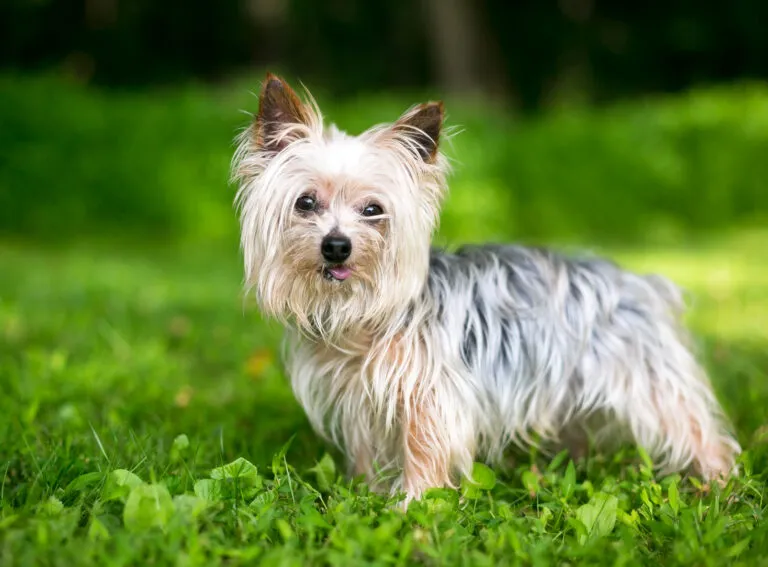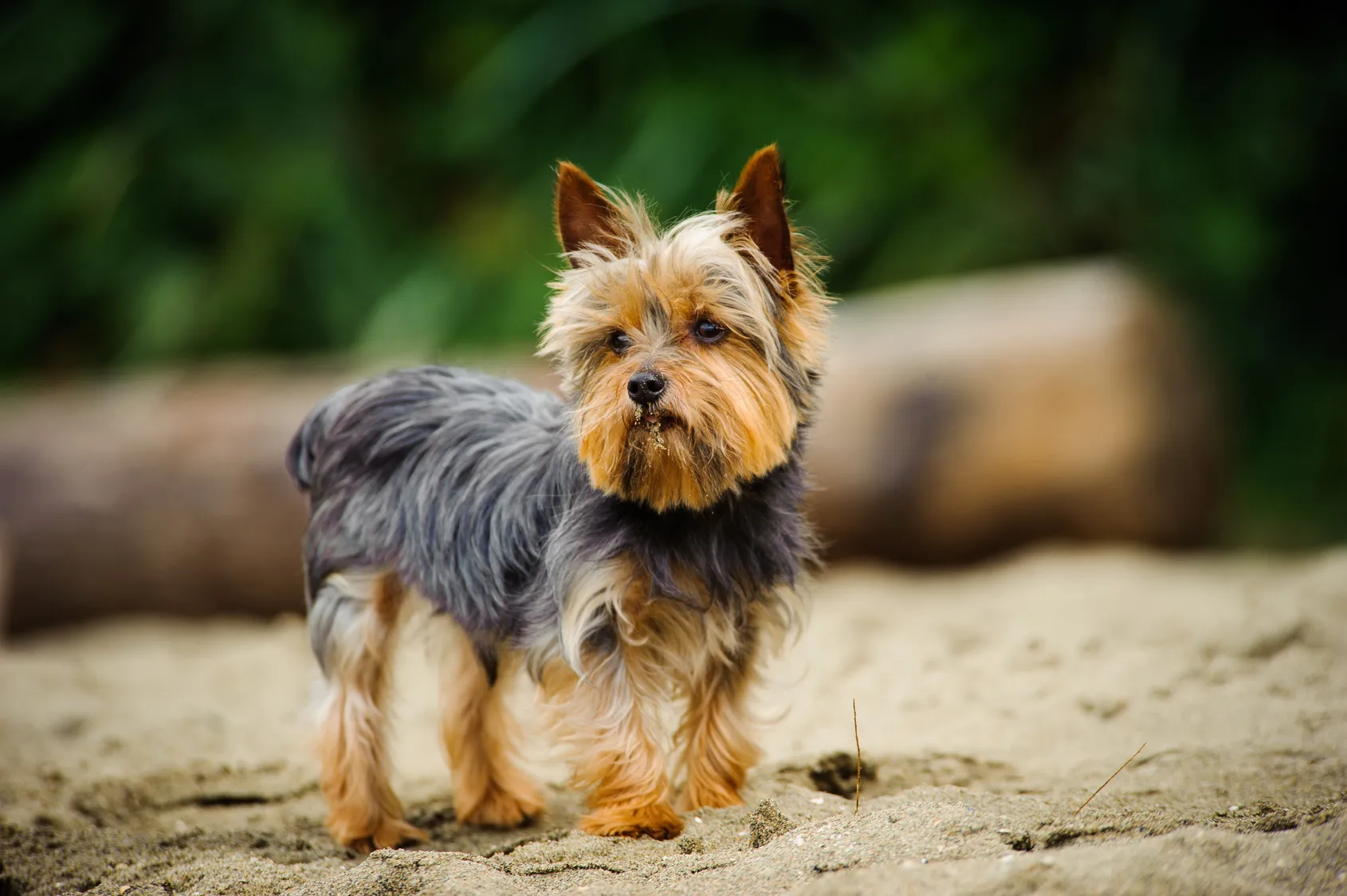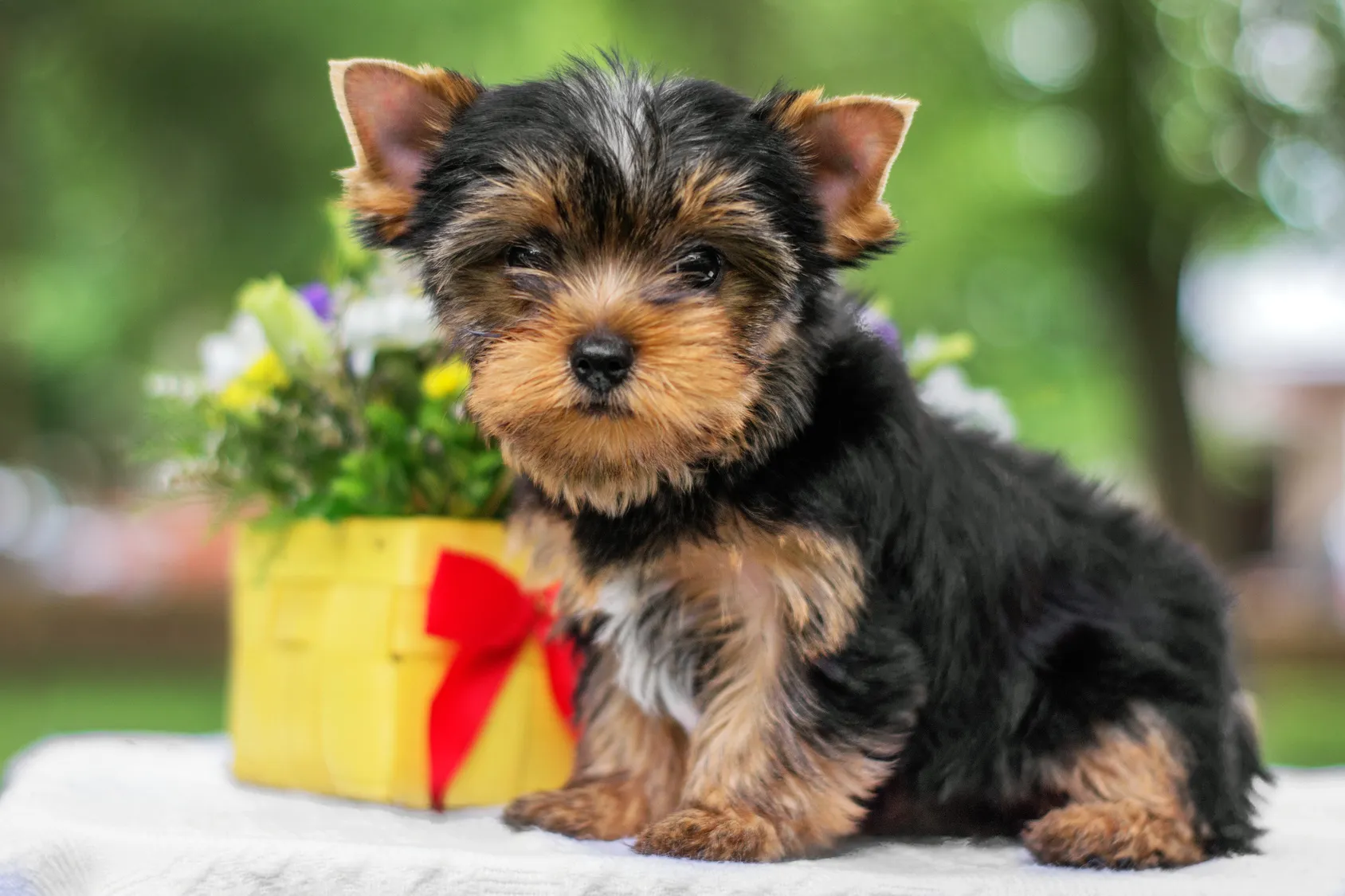Medium Size Poodle
The small Yorkshire Terrier with long, fine fur and a spruce appearance has plenty of tricks behind its little ears. As a former rat catcher from the county of Yorkshire in northern England, this dog is very self-confident and wishes to be taken seriously by its owners as a domestic and companion dog too.

© Mary Swift / stock.adobe.com
The Yorkshire Terrier was originally kept as a rat catcher.
Although the little Yorkshire Terrier with typical ribbons in its fur at first gives a different impression, it is anything but a cute lapdog! There is a true heart of a fighter behind its dapper appearance. Courageous, self-confident and passionate, these tiny dogs never shy away from confrontation with larger canines.
In encounters with other dogs, the little Yorkie often considers itself bigger than it actually is and has an exaggerated opinion of itself. It cheekily stands in the way even of mastiffs and sheepdogs and yaps to show them who’s in charge of its territory. As a true terrier, it defends its home and family tooth and nail if necessary, even if it risks coming off worse. If you wish to keep a Yorkshire Terrier as a family dog, you’d be well advised to put a stop to the excessive dominant tendencies of these small pedigree dogs early on.
Thankfully, the intelligent and alert Yorkshire Terrier is also very curious and willing to learn. They will generally willingly comply with interesting obedience exercises and fun training sessions. Even though they may at times secretly dream of taking the reins themselves, they are more than willing to subordinate to a self-assured and consistent pack leader. If you take your Yorkie seriously and train it suitably, you will find it to be a loyal companion with strong nerves, which stands by its family through thick and thin.
Despite its high self-confidence, the Yorkshire Terrier usually adapts well to its family’s day-to-day life. Thanks to its compact size, it can be taken everywhere without any problems and is undemanding in terms of exercise too. Nevertheless, it should get enough exercise considering it is a former hunting dog that chased after rats and mice through the alleyways of industrial cities in northern England. Along with daily walks, these little whirlwinds also enjoy dog sports, such as agility and flyball, or hunting and search games. The little Yorkie is perfectly happy of it is then allowed to pursue its passion for digging in thick undergrowth to its heart’s content.
You’ll find the suggested products in the video under the following links:
Royal Canin Yorkshire Terrier Adult (Dry Food), Concept for Life Mini Adult (Dry Food), Dog Agility Weave Poles, Dog Agility Jumping Hoop, Trixie Dog Activity Obstacles, Trixie Denta Fun Play Rope, Dog Grooming Supplies
The Yorkshire Terrier is one of the smallest pedigree dogs in the world, reaching 18 to 23cm in height and weighing a maximum of 3.2kg according to the standard.
Its small, compact body is covered by the typically long, smooth and fine fur, which almost entirely covers its straight limbs. Although the coat may reach to the floor with show Yorkies, it should never inhibit the dog in its movements.
The standard only permits one colour combination: golden tan on the head and body with a steel blue cloak stretching from the back of the head to the base of the tail. The tan-coloured hairs must be dark at the roots and become lighter towards the tips. Other colourings are classed as incorrect by the standard.
 © everydoghasastory / stock.adobe.com
© everydoghasastory / stock.adobe.com
The history of these attractive little pedigree dogs is closely linked to industrialisation in Britain. They arrived in cities with the workers, including the now-extinct Clydesdale and Sky Terrier, which are ancestors of the Yorkshire Terrier along with the Maltese and old English Black & Tan Toy Terrier. In order to stem the plague of rats in filthy streets, workers in the northern English county of Yorkshire, which gave the breed its name, began to breed these nimble and courageous toy terriers at the end of the 19th century. The Yorkshire’s original “official” task of hunting mice and rats was soon accompanied by illegal rabbit hunting and gory rat-baiting. In competitions that were popular at that time, the terrier had to kill as many rats as possible in a specified time in what was known as a pit.
The development of the professional kennel club began at the same time as rat fights increasingly drew to a close towards the end of the 19th century. The standardisation of the dog breed led to the onset of dog exhibitions in which the most attractive and “purest” pedigree dogs were rewarded by independent breeding judges. Workers from the poorest districts of Yorkshire soon noticed that they could make a profit from breeding these attractive little terriers. In order to make them popular in aristocratic circles too, especially with refined ladies, the Yorkie’s size and weight was reduced and its long, silky fur was enhanced. Numerous breeds were involved in pairing in order to successfully achieve this goal. In 1886, the Yorkshire Terrier was officially recognised as an independent breed and soon became one of Britain’s most popular toy dogs.
Nowadays Yorkshire Terrier breeders can be found all over the world – from North America and Europe to Russia. Unfortunately they still include some irresponsible breeders hoping to gain a quick buck through bargain online or newspaper ads. Since their puppies have often neither been tested by independent breed wardens nor undergone the recommended health examinations, it’s not uncommon for them to suffer from illnesses or behaviour disorders. In order to avoid nasty surprises and not to further promote the grubby business of these animal traders, you absolutely must steer clear of such unscrupulous offers.
If you and your family have decided to purchase a Yorkshire Terrier and are sure that this little whirlwind of a breed is right for you, you should look for responsible breeders in your area. For instance, registered terrier associations in your country can give you a list with the addresses of trustworthy providers planning new litters. Responsible breeders are generally organised through official associations and thereby comply with both the guidelines of the breed standard and those of the association itself, which often go beyond the usual health examinations and character tests. Contact possible breeders and arrange a face-to-face meeting. This first encounter isn’t about looking for a puppy straight away, but rather forming a comprehensive picture of the breeder.
 © Kate / stock.adobe.com
© Kate / stock.adobe.com
Health and strength of character are the top priority with responsible breeders. After all, a one-sided focus on physical features like the lowest possible weight and longest possible silky fur have led to a number of ailments. The Yorkshire Terrier is still associated with the following diseases typical of the breed:
The best foundation for your Yorkshire Terrier living a long, complaint-free life is healthy genetic material, species-appropriate housing and a healthy balanced diet. As with humans, the right choice of nutrition can significantly increase your dog’s wellbeing. But which food is best for the Yorkshire Terrier? This depends on very individual factors – after all, your dog’s nutritional requirements depend too on its age, size, weight and activity level. At the start, it’s certainly recommended to give it a special puppy food. In most cases, the breeder will give you a food to use at home for the first few weeks.
Discover our selection of dog food for Yorkshire Terriers!
At around 12 months, your Yorkshire Terrier is of adult age and generally only needs one meal per day. At a weight of around 3kg and with a normal activity level, it needs around 100g of meat each day, which is supplemented by feathers, vegetables, boiled rice or pasta. If you wish to put your dog’s food together yourself, you should use a lean or only slightly fatty meat of a high quality. Yorkshire Terriers tolerate well beef, cattle innards like the heart and liver, chicken and raw rumen. You’re better off cooking pork beforehand if you choose this. Other types of meat that you buy fresh can also be served raw. What is known as BARF (biologically appropriate raw food) is now very popular with owners of small dogs too, though does require the owner to have some expert knowledge.
If you wish to save time, you can of course also choose ready-made canned or dry food, which ideally already contains all the important nutrients your dog needs and doesn’t have to be supplemented by mineral or vitamin compounds. However, make sure that ready-made food is of a good quality too and avoid food containing too much grain, sugar, chemical preservatives or artificial flavour enhancers.
Often adorned with little ribbons, you can guess from the Yorkie’s long, silky fur that grooming this attractive pedigree breed is going to require some time and expertise. No worries though, as you will even come to enjoy your dog’s daily grooming routine with a bit of practice. If you get your Yorkie as a puppy, you should get it used to brushing, baths, teeth cleaning, hair trimming and claw cutting from the beginning. With a bit of practice and patience though, adult Yorkshire Terriers too will become accustomed to the necessary grooming procedures.
In contrast to grooming, the Yorkshire Terrier is undemanding when it comes to its domestic environment. These little dogs feel at ease in city apartments too and mostly adapt to their owners’ day-to-day life without any problems – at least provided that you take them seriously and meet their need for exercise and activity. A Yorkie is no lapdog, but a real character with a passion for hunting. It should be allowed outside around three times a day to give it enough stimulation.
Dog sport is also an option along with obligatory walks. These playful and intelligent canines love taking part in agility, flyball or search and retrieval games. Another advantage of dog sport is social contact with other dogs, which terriers definitely need, as otherwise they can be rather headstrong with dominant tendencies. However, these sporty pedigree dogs do not make suitable companions for long jogging or cycling sessions due to their small size and short legs.
Also read our articles on puppies – from training tips, health checks to feeding guides
Here are some purchase proposals curated by the zooplus editorial team
The products featured have been carefully selected by our editorial staff and are available at the zooplus online pet shop. The selection does not constitute advertising for the mentioned brands.
Fans of the Bearded Collie agree that those who aren't familiar with this dog breed simply have to get acquainted with it. And those who have experienced how a Bearded Collie bolts across meadows with its flowing fur, how it rolls around full of energy and joy and how it attentively and observantly takes into account its owners wishes become simply addicted to this original dog breed and its unique charm.
The Goldendoodle isn't a breed, but a pairing between Golden Retrievers and Medium or Standard Poodles. Marketed as a low-maintenance dog for allergy sufferers, this hybrid is enjoying increasing popularity amongst dog lovers, similar to the Labradoodle.